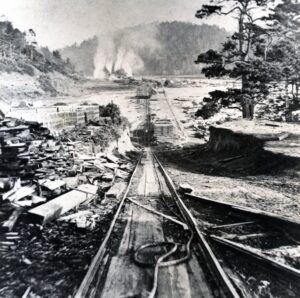Competition is native to the American character. To be first seems of great value. First at the clam chowder cook-off, first in Little League, first in line. Historians prattle about who or what was first. So, let’s prattle about the trains that once rattled through town, carrying lumber to the Point.

A photograph of a stereograph showing the Incline on the tramway from the Big River Mill, where the lumber was cut and planed, to the Shipping Point, where it was stored until loaded onto ships that anchored in Mendocino Bay. The Mill, seen in the background with smoke around it from the wood-fired boilers for the steam engines, was located on the east end of Big River Beach. (Object ID #1973-182-1218, Alice Earl Wilder Collection, Kelley House Museum)
That energetic enterprise began in 1852, when Captain David Lansing and his men laid wooden railroad tracks at the sawmill located then on the Point. Captain Lansing had been skippered of the brig Ontario which brought sawmill equipment and workmen to Mendocino in July of 1852.
He was appointed shipping superintendent for the lumber operation and designed a railroad consisting of 180 feet of wooden tracks which curved through stacks of lumber stored at the Point. The motive power was teams of oxen, bulls or horses. Small rail cars carried sawn lumber to be stacked out there to lose moisture in the wind before shipment by vessel to San Francisco. Air-dried, it was called.
Once seasoned, the lumber was tugged along the tracks to the ship-loading chutes perched on the cliffs. Schooners lay under the chutes and boards skidded down the chutes, one at a time, to be caught by crewmen who stowed the wood below or on deck.
When a second, more efficient sawmill was built on the Big River flats the following year, Lansing laid tracks eastward, using iron rails instead of redwood. This rail line connected the new mill and the Point. The railroad had to surmount a steep rise from the flats to the headlands.
The solution was described as follows: “Here the loaded cars were lifted up 64 feet on an inclined track by rope and winch, one car at a time, to the top. The oxen or horses walked by trail to the top and then pulled the cars to the shipping point, a distance of about one [more] mile. The empty cars were then returned to the original lifting point, lowered by the rope and winch, and then [travelled] down to the mill, by gravity, to be loaded for the return trip.” By 1855, Lansing’s railroad was carrying tons of lumber and logs every working day.
In June 1855, a ship tied up at a Sacramento River levee to discharge a consignment of British made rails and railroad cars that had been brought around Cape Horn. On August 9, the first rail was spiked to a tie made of laurel wood (they had yet to learn how rot- and insect-resistant redwood ties were.) Two days later, four men set a handcar on the rails and took what they claimed to be the first railroad ride in the new state of California—a ride of 400 feet. One of the men on that handcar was Theodore Judah, who would become chief engineer for the new railroad.
A few days later, when the “right-of-way” was several hundred feet longer, the first locomotive, named “Sacramento,” was swung onto the tracks. Pulled by the imported British steam engine, a bunch of brass hats took a ride out to the rail head.
Judah took charge of surveying and laying out the railroad’s route over the Sierras, at Donner Pass, to an altitude of 7,027 feet. He died in 1863, and never saw completion of the transcontinental railroad, on May 10, 1869, at Promontory Point. There the famous gold spike was driven into a redwood tie. A redwood tie? Yes. Ties made on the Mendocino Coast. Hundreds of thousands of redwood ties were laid on the Central Pacific right-of-way.
Those boastful Sacramento railroaders, the Big Four, claimed to have built the first railroad in California and celebrated by a short handcar ride in Sacramento. Really? On the Mendocino Coast, we don’t feel the need to boast. (Sounds like a song title.)
Visit the Kelley House Museum – open Thursdays through Sundays 11 am to 3 pm. Book our popular walking tour of the Mendocino Historic District at our website kelleyhousemuseum.org.